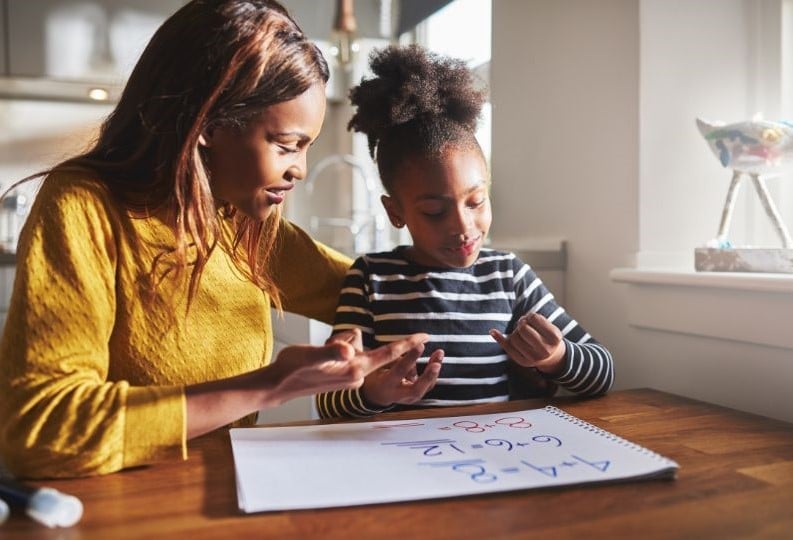
A solid mathematical foundation opens up a world of future possibilities. Many studies and discussions have centered on how to help kids become more proficient mathematicians and strategies and tactics that have been proposed to help children get better at math. As a parent, one of your most important responsibilities is to support your child’s math abilities. Help your child get better at math with these 17 tips.
1. Play a part
Get involved in math-related activities and offer assistance and motivation. Children with parents actively involved in their education typically have higher academic achievement. Engage your child in the education process. Attend parent-teacher conferences, check exams and assignments, and assist students with their homework. If you take an interest in what they are learning about math, they will feel more motivated and confident.
2. Develop a growth mindset
A growth mindset is based on the belief that one’s qualities can be cultivated through effort. Encourage your child to believe practice and effort will make them more proficient in math. Teach them that learning involves making mistakes and that perseverance pays off. This mindset fosters resilience and a positive outlook when math gets challenging.
3. Praise effort, not just results
In a study, researchers asked 400 fifth graders to take an easy short test, on which almost all performed well. Half the children were then praised for “being really smart.” The other half were complimented on “having worked really hard.” The children were then asked to take a second test and choose between one that was pretty simple and that they would do well on and one that was more challenging and they might make mistakes on. Ninety percent of those praised for their effort chose the harder test. Most praised for being smart chose the easy test.
4. Exercise counting
The ability to count is one of the fundamentals of early learning and is an essential skill for children to learn before starting their first year of school. Counting continues to be a vital number sense skill that students need to know to understand more complex math concepts. Make sure your child can count well. Practice counting objects and counting in ones before counting by twos, fives, and tens.
5. Apply math in real life
Get your child involved in real-life math, from counting the money in your wallet, buying things and getting change, playing games that need scoring, counting spaces on board games, measuring in cooking and baking, looking at train timetables, working out how long something will take, to using maps relating to coordinates. Get them to help you measure for that new pair of curtains or measure the chest of drawers to see if it will fit in the new spot. These everyday learning opportunities are much more valuable than the worksheet you can download off the internet.
6. Learn times tables
Multiplication is foundational to many forms of math, such as algebra, calculus, and equations. The ability to rehearse and understand multiplications up to and including 12 will enable your child to tackle more complex math topics confidently and skillfully. Assist your child in learning the multiplication tables by heart. Utilize apps, music, or flashcards to add interest and fun to the process.
7. Use real objects for calculations
When you are working with calculations, use real objects. “I had twenty toy cars but gave you four. How many are left?” Show that you can count them again, or you can count back the four from twenty. It’s the same with fractions — get a cake or a chocolate bar and chop it up. Anchoring math in reality helps children understand what is happening to their calculations or fractions and prepares them to move on to abstract images or numerical representations.
8. Don’t stick to just one calculation method
Look at a question together to decide on the best method. Is there an easy way to do this in our head? For example, 19,998 + 3999. Many children see large numbers and jump to the formal column method they’ve been taught, even though this is time-consuming and involves exchange, with many opportunities for an error. Looking at the numbers again, we can see that 20,000 + 4,000 – 3 would be a much easier way to do it. Get a random selection of calculations and look at how we could solve them — what are the best ways?
9. Practice mental math
Encourage your child to solve problems in their head. Mental math enhances quick and accurate calculation skills, improves number sense, develops working memory, and keeps the brain sharp. Play UNO regularly to help your child develop their mental math skills as they quickly calculate and compare the values of the cards.
10. Boost visual memory
Visual memory is the ability to recall what the eyes have seen and is considered to be among the skills significantly related to mathematics achievement. Develop your child’s visual memory with puzzles, memory games, and other activities that require them to manipulate and recall visual information. Also, consider programs like Edublox’s Development Tutor. In a research study, an intensive Edublox program improved visual memory by 1.3 years in 5 days.
11. Encourage mathematical reasoning
Reasoning in math is applying logical thinking to a situation to derive the correct problem-solving strategy for a given question and using this method to develop and describe a solution. Give your child logical thinking quizzes and critical thinking exercises to solve. As they consider various options, help them justify their decisions. From this practice, they will gain analytical abilities and a deeper comprehension of mathematical ideas.
12. Use math apps and games
Utilizing technology can make math learning enjoyable. Many educational apps and online games aim to improve math skills through interactive and exciting activities. Select apps for your child based on their age and curriculum.
13. Read math-related books

During reading time, incorporate math concepts and problems by selecting books with mathematical themes. Math stories can add fun to the subject and help your kids understand its importance.
14. Set realistic goals
Together, help your child create attainable math objectives. Divide more ambitious goals into more doable, smaller tasks. Recognizing little accomplishments along the road helps them stay motivated and progress-focused.
15. Create a positive math environment
Encourage your family to have a positive outlook on math. Display interest and excitement instead of expressing disapproval or negativity toward the topic. A supportive environment fosters a love of learning math.
16. Practice regularly
The secret to mastering math is consistency. Make studying a regular habit that includes practicing math every day. Frequent, short sessions work better than long, infrequent ones.
17. Seek additional resources
If your child has trouble with math, consider looking for extra assistance. Personalized instruction and support can be obtained through tutors, online courses, and educational workshops. Additional resources can help your child feel more confident and address particular areas of difficulty.
A positive attitude, a variety of tools and strategies, and consistent effort are all necessary for becoming proficient in math. You can support your child’s math growth by implementing these 17 strategies. Never forget that your encouragement and participation greatly influence their success in math.
